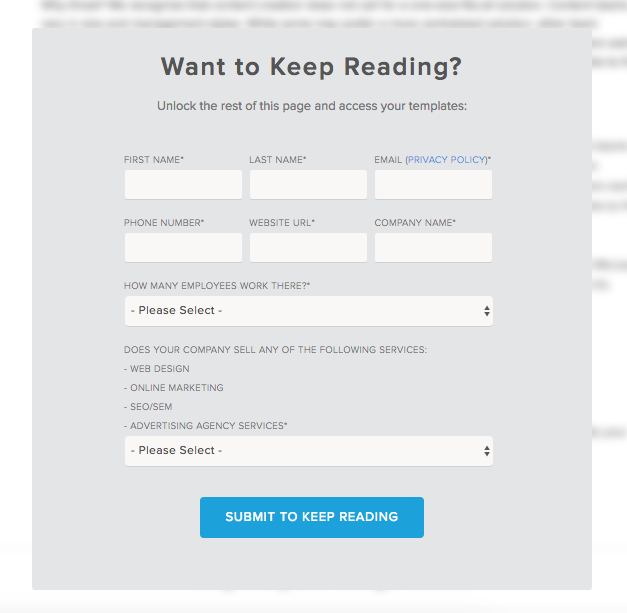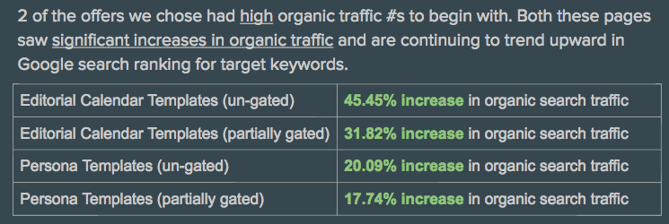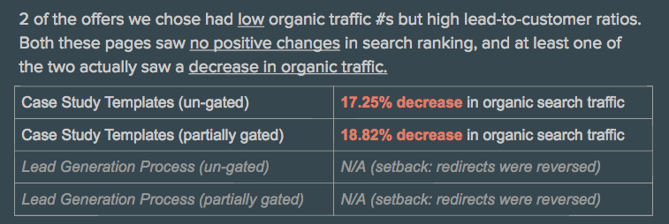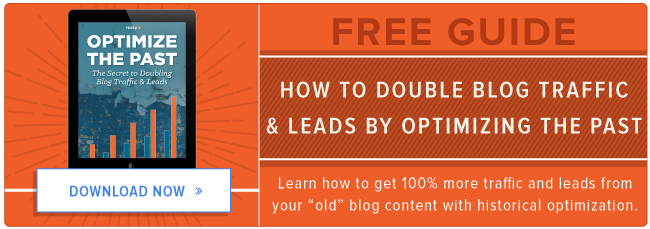
Whether you love ‘em or hate ‘em, chances are, you have an opinion about forms.
Trust us -- they’re not evil. We still use them, and still believe that many marketers should continue to do so, too. But truth be told, the "Should we gate our content?" question has been flying around HubSpot for a few years now. We’ve looked at the topic through various lenses, from SEO, to lead generation, to channel-specific implications.
After all, gated offers tend to provide fairly consistent lead volume and lead-to-customer conversion rates.
But at the same time, it turned out that we had a lot of landing pages for our offers -- the gates, if you will, that weren’t getting much organic search traffic. We might have been optimizing the landing pages for search, but we weren’t doing the same for the juicy, valuable, in-depth content inside the offer itself.

We had a lot of questions. Among them:
- Is locking all that valuable content behind a landing page and disallowing Google from ranking it ultimately hurting us from an SEO standpoint?
- Are PDFs dying as a format?
- Is there a way we can get people to convert on our offers when they live directly on a webpage?
Then, we thought, maybe we could find a best-of-both-worlds scenario. Maybe, if we took an SEO-heavy approach to un-gating our content, we would find ourselves with more keyword-optimized indexed pages that could appear in search engine results pages. The idea: a partially un-gated version of the page, where users could scroll to a certain point, and have to fill out a form to "unlock" the rest of the content. That would mean phasing out PDFs, and replacing them with new HTML site pages with offer content optimized for both search and conversions.
And so, we designed an experiment to answer the question: Will the combination of more organic traffic + smarter conversion assets on HTML pages lead to net better organic conversions?
We split this experiment into two parts. Below is an overview of Part I -- stay tuned for Part II.
Does Un-gating Offers Improve SEO and Conversion Rate Optimization?
The Hypothesis and Objective
We hypothesized that, with these variations, Google would have enough content to crawl on these new HTML pages to give it a significant SEO boost -- but that by partially gating the content, we could still generate leads from it.
We were interested to see how the lead volume would change here, which was easy to measure, but we also wanted to know would affect user experience -- which was a little tougher to measure.
So, we had two pillars to the experiment, each with its own sub-hypothesis.
The SEO Test
Hypothesis: We have a lot of offer landing pages that aren't getting much organic search traffic. By un-gating these offers, we'll be able to increase organic search traffic.
Objective: Increase organic search traffic and Google search engine results page (SERP) ranking of offer content.
The Conversion Rate Optimization (CRO) Test
Hypothesis: If we un-gate offer pages and then gate the content with a on-page form that triggers on scroll, the net conversions will exceed the PDF versions of the pages.
Objective: Increase organic traffic and conversion rate on new site pages to meet or surpass net conversions of original landing pages.
The Experiment
Choosing What to Un-gate
To start, we organized all of HubSpot’s current offers into broader topic categories. Then, we looked at data from each offer to see how much of the following it was generating:
- Net-new leads
- Opportunities
- Customers
That helped us determine which of the offers (and overarching topics) had the greatest impact on revenue. From there, we were able to identify a list of between 20-30 offers that had the highest potential for adaptation from PDF to site pages, and prioritized them based according to SEO performance, SEO potential, and lead-to-customer ratios.
Based on the findings below, we determined that we'd start with the following four topics: blogging, buyer persona, case studies, and lead generation.
| First Conversion Topic Cluser | Organic Traffic | Lead to Opp rate |
| Blogging | HIGH | 29% |
| Buyer Persona | HIGH | 81% |
| Case Studies | LOW | 59% |
| Lead Generation | LOW | 62% |
We started with four offers:
- Two with high organic traffic, but low-to-average conversion rates.
- Two with high lead-to-customer rates and really great content, but that weren't ranking well for search in their original form.
This may seem like too small of a sample for us to truly understand whether retiring PDFs works. That’s why we framed Part I as a "test to refine the test" -- a test that would help us iron out the kinks in our logic before we scaled it.
For each one of these offers, we ran an A/B test.
- Version A: A completely un-gated version of the page. In this version, there were other conversion opportunities sprinkled throughout the page, including an embedded form at the very bottom for a related offer.
- Version B: A partially un-gated version of the page, where users start reading the offer, scrolling to a point on the page where the content blurs and they're greeted with an interstitial form, which they’d have to fill out to continue reading the content on the page. Here’s what this ended up looking like:

Moving From PDF to HTML
After we chose the list of offers to test, we moved the content of each of one from PDF to HTML. The steps we took were as follows:
- Assess which keyword(s) the offer's landing page is currently ranking for.
- Update/re-write the offer's PDF content so it is fully optimized for those keywords.
- Compress any images using TinyPNG to save on page load time (this is an important step for SEO).
- Place the optimized content onto a new site page.
- Create a new campaign for the site page, to which all URLs on the new page are linked to track clicks/conversions.
- Optimize the page for conversion by adding CTAs, with tracking URLs, that we felt fit into the context of what the site visitor is already doing.
- Create a B variant of the page, and create new tracking URLs for those site pages, so we could track conversions individually for both versions of the page later.
- Choose a secondary offer on a topic related to the one on the page that could be linked to via an embedded form at the very bottom of the fully un-gated page.
- Publish the page, and redirect this new URL to the original one to leverage any existing authority the author might have -- then, submit the page to Google to re-crawl.
- Wait for statistically significant results.
The Results
The SEO Test
In the end, we were only able to increase organic search traffic and Google SERP ranking to the pages that were already performing well for organic search -- and, therefore, had pre-existing search authority.


Unfortunately, our fourth offer was redirected without our knowledge, so we weren’t able to collect results during the same time period. When we returned to the Lead Generation Process page results later, we found no positive impact on organic search traffic that we could attribute to un-gating the content.
The Conversion Rate Optimization (CRO) Test
Truth time: We failed to optimize these pages for conversion to the point where they even came close to matching -- much less surpassing -- the net conversions of the original landing pages.



What We Learned, and What's Next
When it came to the SEO side of our experiment, it was surprising to us that we were only able to see organic traffic increases from offers that were already doing well in search. From an organic standpoint, then, one might conclude that we should focus on un-gating only the offers that are already generating significant organic traffic, and have pre-existing search authority.
As for the CRO site, clearly, the partial gating template didn’t work for conversions. We decided to apply a fun hashtag to the outcome -- #FailFast -- and conclude that it was time to experiment with other forms of gating and CRO.
Next steps? In order to avoid putting a lot of conversions at risk, the results indicated that we had to conduct our CRO tests on the offer landing pages that we already experimented with -- until we found a conversion method that works well. Once that happened, we could replicate it on other, high-organic-traffic landing pages.
We also saw that, in order to warrant un-gating more pages, we’d have to run a series of CRO tests with the goal of increasing organic conversion rates significantly enough.
These are just some of the things that you can look forward to reading about in Part II -- stay tuned.



No comments:
Post a Comment